Gabu
| Gabu | ||
|---|---|---|
|
|
||
| Coordinates | 12 ° 17 ′ N , 14 ° 14 ′ W | |
| Basic data | ||
| Country | Guinea-Bissau | |
| Leste | ||
| region | Gabu | |
| ISO 3166-2 | GW-GA | |
| surface | 2,122.8 km² | |
| Residents | 81,495 (2009) | |
| density | 38.4 Ew. / km² | |
|
Location of the Gabú (yellow) sector in the Gabú region
|
||
Gabú (until 1974 Nova Lamego ) is the largest city in eastern Guinea-Bissau and the capital of the Gabú region . It has 41,612 inhabitants.
Gabú is the seat of the administrative sector of the same name with an area of 2123 km² and 41,612 inhabitants (as of 2009).
history
Around 1200, Mandinka immigrated to the region. The Kaabu empire that was created here remained tributary to the Mali empire until it declared itself independent in 1537. Gabú became its capital.
The Kaabu Empire traded with the Portuguese, who had their first trading post in Cacheu since 1588 . Kaabu supplied the Portuguese in particular slaves and exchanged u. a. modern firearms.
The Fulbe empire Fouta Djallon , which then became increasingly rebellious , was able to severely defeat Kaabu in the Battle of Kansalá on May 19, 1864 and then expanded its control of the region, while Kaabu went under from 1866.
From the 17th century the Portuguese increasingly took possession of the hinterland of their colony, and in 1915 they subjugated the last independent tribes. In the 1930s and 1940s, the Portuguese also expanded the trading city of Gabú into an administrative city.
Until the independence of Guinea-Bissau in 1974, the city carried the colonial place name Nova Lamego.
Residents
The city of Gabú has 41,612 inhabitants according to data from the 2009 census . Today, the city is mainly inhabited by Muslim Fulani .
structure
The Gabú sector comprises 188 localities, mostly rural villages ( Tabancas ).
The sector capital Gabú is divided into 17 districts ( Bairros ). The most important locations in the sector also include:
- Bambadinca (not the city of the sector of the same name)
- Banje
- Canhaque
- Canjadude
- Carabel
- Coiada
- Gataba Afia
- Huda
- Sintchã Tombo
- Sumacunda
Culture and sights
The handicrafts Gabús is known nationwide, but is hardly practiced anymore.
Only a few buildings from colonial times can be seen here, including the town's church.
On the outskirts of Gabús, the Grutas de Nhampassaré are worth visiting rock formations. There are also the eponymous caves that show traces of prehistoric human settlement, in particular rock engravings.
Economy and Transport
Gabú is located in the driest area of the otherwise very humid Guinea-Bissau, although some forest areas exist here. In the savannahs of the region, it is mainly the Fulani who do grazing. Agriculture and especially trade with the neighboring countries Senegal and Guinea-Conakry are the other pillars of Gabús. After the capital Bissau, the city is now the largest trading center in the country.
In contrast to the rest of Guinea-Bissau, donkeys are widespread here as transport and work animals.
Gabú can be reached via an asphalt, comparatively good country road from the capital Bissau, which is 263 km away. There are hardly any paved roads in the city itself.
The city has an airfield with the ICAO code GGGB.
Web links
Individual evidence
- ↑ a b Inhabitants by region, sector and town by gender, 2009 census (p. 124, port.), PDF retrieval from the National Statistics Office INE of December 30, 2017
- ↑ Annual Statistical Report Guinea-Bissau 2015 (p. 10), PDF access from the National Statistics Office INE of December 30, 2017
- ↑ Joana Petrolho, Marta Rosa: À Descoberta da Guiné-Bissau . , Afectos com Letras / EU, Pombal 2015, ISBN 978-989-20-6252-5 , p. 11
- ^ Francisco Henriques da Silva, Mário Beja Santos: Da Guiné Portuguesa à Guiné-Bissau - To Roteiro. Fronteira do Caos Editores, Porto 2014 ISBN 978-989-8647-18-4 , p. 30f and p. 82
- ↑ Joana Petrolho, Marta Rosa: À Descoberta da Guiné-Bissau. , Afectos com Letras / EU, Pombal 2015, ISBN 978-989-20-6252-5 , p. 84
- ↑ Joana Petrolho, Marta Rosa: À Descoberta da Guiné-Bissau. , Afectos com Letras / EU, Pombal 2015, ISBN 978-989-20-6252-5 , p. 81f



